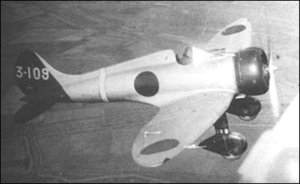Mitsubishi A5M
|
|
| Mitsubishi A5M | ||
|---|---|---|
 Mitsubishi A5M | ||
| Description | ||
| Role | Carrier-based fighter | |
| Crew | One | |
| First Flight | February 4, 1935 | |
| Entered Service | 1937 | |
| Manufacturer | Mitsubishi | |
| Dimensions | ||
| Length | 24 ft 10 in | 7.6 m |
| Wingspan | 36 ft 1 in | 11.0 m |
| Height | 10 ft 9 in | 3.3 m |
| Wing area | 191.6 ft² | 17.8 m² |
| Weights | ||
| Empty | 2,681 lb | 1,216 kg |
| Loaded | 3,694 lb | 1,676 kg |
| Maximum takeoff | lb | kg |
| Powerplant | ||
| Engine | Nakajima Kotobuki 41 9-cylinder radial | |
| Power | 785 hp | 585 kW |
| Performance | ||
| Maximum speed | 270 mph | 435 km/h |
| Combat range | 746 mi | 1,200 km |
| Ferry range | mi | km |
| Service ceiling | 32,150 ft | 9,800 m |
| Rate of climb | ft/min | m/min |
| Wing loading | 19.2 lb/ft² | 93.7 kg/m² |
| Power/Mass | 0.192 hp/lb | 316 W/kg |
| Armament | ||
| Guns | 2 fuselage-mounted 7.7 mm machine guns | |
The Mitsubishi A5M was the world's first monoplane shipboard fighter and the direct ancestor of the famous Mitsubishi A6M 'Zero'. The Allied code-name was Claude; the Japanese Navy designation was "Type 96 carrier-based fighter" (九六式艦上戦闘機).
Designed to a 1934 specification, the plane first flew on February 4, 1935. It exceeded most expectations, in particular top speed (215 mph (346 km/h) was specified, 280 mph (450 km/h) attained). After some work to improve stability, the aircraft entered service in early 1937, soon seeing action in the Sino-Japanese War.
There, they proved themselves the better of every aircraft they encountered, though the Mitsubishi team continued to improve the A5M, working through versions until the final A5M5, which added a ventral drop-tank for extended range.
A trainer version, the A5M4-K was also built (103 examples). This had twin cockpits and continued in use for fighter training long after the regular A5M left front-line service.
Almost all A5Ms had open cockpits; a closed cockpit was tried, but found little favor among Navy aviators. All had fixed, non-retractable undercarriage with (except for the trainers) wheel spats (fairings).
Some A5Ms were still in service at the beginning of World War II. United States intelligence sources believed the A5M was still the primary Navy fighter, but most were out of service at that time, replaced by the A6M 'Zero'.
Most remaining airframes were used for kamikaze attacks in the closing months of the war.
| Related content | |
|---|---|
| Related Development | |
| Similar Aircraft | |
| Designation Series | |
| Related Lists |
List of military aircraft of Japan - List of fighter aircraft |
|
Lists of Aircraft | Aircraft manufacturers | Aircraft engines | Aircraft engine manufacturers Airports | Airlines | Air forces | Aircraft weapons | Missiles | Timeline of aviation |
